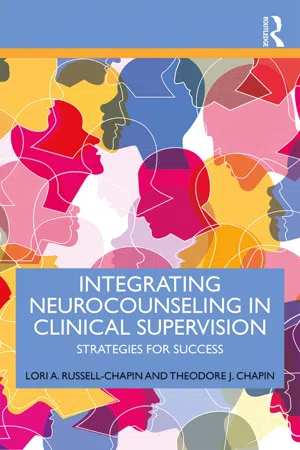
Integrating Neurocounseling in Clinical Supervision
Strategies for Success
- 226 pages
- English
- ePUB (mobile friendly)
- Available on iOS & Android
Integrating Neurocounseling in Clinical Supervision
Strategies for Success
About This Book
Integrating Neurocounseling in Clinical Supervision provides an indispensable framework for understanding supervision using neuroscience. Chapters explore a range of topics, from basic neuroanatomy to the complexities of the default mode network. Beginning with overviews of supervision and of common challenges and ethical concerns, the book presents five supervision models, allowing the supervisor to select the best fit for each supervisee and each question. By combining supervision theory, practical applications, discussion questions, and case studies and demonstrations, the authors prepare counselors to be more intentional about brain functions to increase the efficacy of supervision. New video demonstrations available on the companion website emphasize client outcomes for each of the five supervision models and one group counseling scenario, connecting directly to chapter content and demonstrating the major elements of each model.
Frequently asked questions
Information
1
A CLARIFYING VIEW OF SUPERVISION
Overview
Goals
- Understand the need for a holistic, integrative supervision book.
- Define supervision and its major components.
- Explain how clinical supervision is an integral part of professionalism.
- Identify brain structures and functions that impact clinical supervision.
Supervision Defined
Supervision is an intervention provided by a senior member of a profession to a junior member or members of that same profession. This relationship is: evaluative, extends over time and has the simultaneous purposes of enhancing the professional functioning of the more junior person(s), monitoring the quality of professional services offered to clients that she, he or they see(s), and serving as a gatekeeper of those who are to enter a particular profession. (p. 8).
- What is your definition of supervision?

- What do you believe the benefits of supervision might be for you?

The Process of Supervision
- All professional staff are required to participate in clinical supervision. Staff may choose from two supervision formats, individual or group. Group supervision will be provided twice a month (once a month in June, July and August), at no cost to staff. Individual supervision must be arranged privately. All staff are required to attend group supervision a minimum of two hours a month or individual supervision one hour a month. Any other arrangement must be approved by the group’s Chief Clinical Supervisor (CCS), Ted Chapin, Ph.D. Check your professional association’s supervision requirement to determine how much supervision you need. Pressing clinical issues that cannot wait for scheduled supervision, are to be brought to immediate supervisory attention.
- All supervisory discussions will be appropriately documented and filed with the CCS. The documentation is to include the date, counselor name, client name, supervisory issue, recommended action and as indicated, resolution. In addition, the name of each person attending supervision will also be noted.
- All clinical staff are expected to follow their respective professional ethical guidelines and are further required to give special attention to the following primary clinical duties, presenting any such issue for immediate supervision.
- Duty to prevent client from harming self or others.
- Duty to protect client confidentiality.
- Duty to provide for client continuity of service.
- Duty to keep adequate clinical records.
- Duty to properly diagnose and treat clients.
- Duty to avoid dual relationships and sexual impropriety.
- All office staff (clerical, accounting, data management, and administrative) must also as appropriate, follow and/or be mindful of the above primary duties, presenting any such issue to their immediate supervisor for feedback, clarification, and/or appropriate action.
All clinical staff are to make reasonable arrangements for their client’s care should they be unavailable due to vacation or illness. This ...
Table of contents
- Cover
- Half Title
- Title Page
- Copyright Page
- Table of Contents
- About the Authors
- Preface
- Acknowledgments
- Chapter 1 A Clarifying View of Supervision
- Chapter 2 Obstacles to Effective Supervision
- Chapter 3 Ethics in Counseling Supervision
- Chapter 4 Developmental Supervision Models
- Chapter 5 Theoretical-Specific Supervision Models
- Chapter 6 Social Role Supervision Models
- Chapter 7 Integrated Models of Supervision
- Chapter 8 Interpersonal Process Recall
- Chapter 9 Benefits of Group Supervision
- Chapter 10 Future Trends in Supervision
- Index